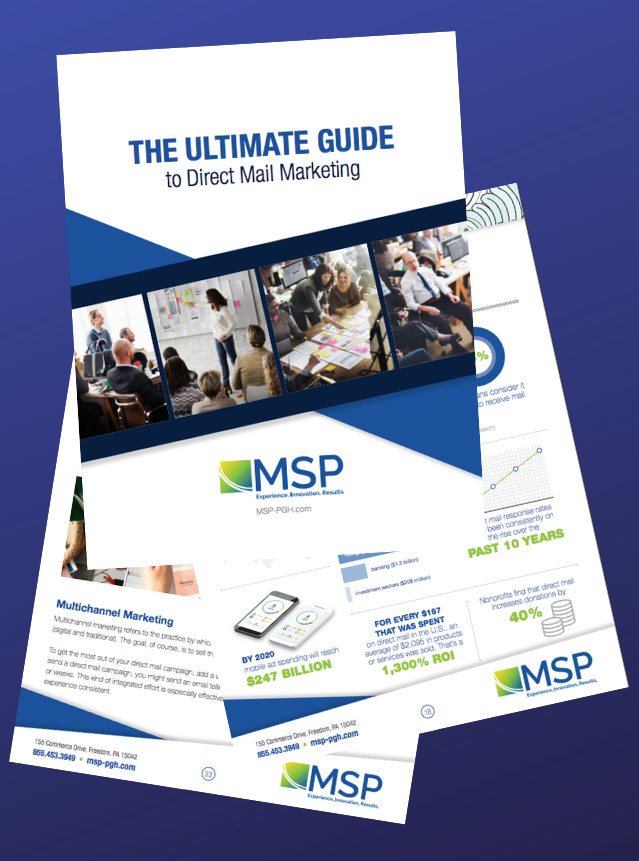Did you know the United States Postal Service sent more than 77-billion pieces of marketing mail in 2018? That’s one of many surprising direct mail marketing statistics for those who thought the long-running direct response channel was fading.
Direct mail still works, even in a digital age where mobile ad spending expects to reach $247 billion by 2020. An urban legend for marketers and business owners is that direct mail is an antiquated marketing medium. But there are too many statistics to back up its validity. In fact, direct mail industry response rates have been consistently on the rise over the past 10 years.
Let’s look at the proof behind the case for direct mail marketing with these 10 surprising statistics.
1. Direct Mail is Less Annoying Than the Internet

It’s also one of the reasons people label the direct mail they receive as less annoying than the Internet.
As a result, in the past decade, print has enjoyed a resurgence of increased conversion rates and marketing ROI. According to PrintIsBig.com, print is 43% less annoying than the Internet. In fact, the USPS confirms that people generally enjoy receiving a postcard, an attractive catalog, or a personal thank-you note in the mail. (Keep reading.)
2. People Sort Through Their Mail Immediately
There’s a good chance you retrieve your mail a walking distance from your front door. If you live in a house, you might have to stroll up your driveway. If you live in an apartment, maybe it’s a walk down a long hallway, a flight of stairs, or an elevator ride. Do you tuck the mail under your arm and enjoy your surroundings? Probably not. You’d be of the minority if you did.
According to the USPS, 77% of people sort through their mail immediately upon pulling it from their mailboxes. There’s simply too much suspense about what’s in that pile of letters. Plus, if there’s a large envelope or package, you can be sure you’re intrigued enough to see who it’s from, at the very least. No other media channel provides this kind of opportunity to get your message noticed right away.
3. Americans Love Mail

A trip to the mailbox has been and likely always will be a popular and beloved journey. It’s a tactile experience—like opening a gift—and it’s perceived as more personal than email. Plus the tangible aspect makes it more memorable. All these things help to create a joyful direct mail experience.
4. Millennials Love Mail, Too
Direct mail isn’t just for “old-fashioned people.” Consider this scene. Did you ever greet your carrier at the mailbox to have a pleasant conversation? To some people, those were the good old days. Life was slower. People actually talked to one another rather than gazing into a phone screen all day. Maybe you loved getting mail as a kid and you still do. It’s sort of ingrained in you to look forward to it each day.
That’s all fine, but there’s a new generation who also loves getting mail. Those fast-paced millennials.
Generation Y is best known for their love of tweets and texts, but they’re not as glued to their smartphones as many would like to think. According to a Gallup poll, a surprising 95% say they love getting physical mail. About 92% of them think it’s easier to read print marketing than digital content. Furthermore, millennials respond to direct mail faster than any other age group—and over 60% of those respondents went on to make a purchase within three months.
5. The Direct Mail Industry Gets Great Response Rates

By comparison, the most popular online channels fall short of response rates for direct mail. Email receives a 0.1% response rate. Paid search has a 0.6% response rate. Social media is at 0.4%. Online display advertising is 0.2%.
6. Direct Mail ROI is High
Beyond getting responses to your direct mail marketing efforts, you ultimately want to turn those interested parties into paying customers. You want your recipients to take advantage of the offer in your mailer. What kind of ROI can you expect? According to the DMA, the direct mail median household return on investment is 29%.
An online display ad might be cheaper, but even if you spend more than what you would on a banner ad, you could receive a bigger return with direct mail. As a smart marketing professional, you want to create a strategy that incorporates a combination of both online and offline channels—aka a multichannel or omnichannel approach. Direct mail marketing is a method you should be taking advantage of, especially when you compare it to the other available channels, like email, paid search, social media, online display advertising, and more.
7. Direct Mail is a $44-Billion Industry

For every $167 that was spent on direct mail in the U.S., products or services sold for an average of $2,095. That’s a 1,300% return on investment.
Naturally, your results will vary depending on how much you spend on the design and copy of your marketing piece, plus the purchase of a targeted direct mail list (if applicable), and the printing and mailing costs. It also depends on the size, type, and quantity of direct mail you’re delivering. The bottom line, however, is that direct mail works and there’s no end in sight to its effectiveness.
8. Financial Services Use Direct Mail the Most
So, who’s spending all these direct mail marketing dollars? Direct mail is relevant to any industry, of course, but there are a few, in particular, that have thrived using it. For instance, financial services companies are the heaviest users of the direct mail industry. This includes the insurance industry ($5.8 billion), credit cards ($5 billion), mortgage and loans ($4.8 billion), banking ($1.3 billion), and investment sectors ($208 million).
The financial services industry is built for direct mail. As a results-driven trade, direct mail campaigns give financial businesses what they desire: measurable results. Marketers in this industry know the numbers they need to reach to accomplish their objectives for a campaign. That’s why large financial institutions send out millions of targeted direct mail pieces each year.
9. Direct Mail Increases Donations for Nonprofits

For nonprofits to succeed at securing funds, potential donors need to believe in the cause. But they also need to trust them. That’s where the direct mail industry delivers. About 56% of customers trust print marketing more than any other type. Plus, direct mail for nonprofits is highly targetable, relatively inexpensive, and completely trackable. How does all this add up? The proof is in the numbers. Nonprofits that use targeted direct mail increase their donations by an impressive 40%. That makes this marketing channel seem like a no-brainer for any charitable venture.
10. Direct Mail Catalogs Get People to Act
You’d think an email would be the best way to get consumers to visit your brand’s website. And it is a good way. After all, they only need to click on a link. But what you may find surprising is that a piece of direct mail also creates an outstanding incentive to visit your site. Direct mail, especially catalogs, can help you drive traffic. Over 60% of direct mail recipients visited a website, especially first-time shoppers.
A printed catalog also makes a recipient more inclined to buy something online—as opposed to someone who doesn’t receive the same piece. According to a USPS study, a piece of direct mail is like window shopping. Catalog recipients bought 28% more than those that didn’t receive the same catalog. Plus, websites that supplemented their sales strategy with catalogs saw a 163% revenue spike.
Create Your Own Direct Mail Marketing Statistics
Direct mail is a proven way to get advertising messages into consumers’ hands. Thus, it’s a viable option for marketing professionals who want results without allocating their entire budget to one channel.
When you factor in the design of your direct mail marketing campaign, plus the printing and postage costs, it may seem like an expensive endeavor, but it doesn’t have to be. Partner with a knowledgeable direct mail fulfillment services provider, to better manage your spending while delivering targeted direct mail marketing campaigns. Contact MSP for a free consultation today.
How Effective is Direct Mail Marketing?
As a smart marketing professional, you know that direct mail is a wise choice to include in your multichannel arsenal. But exactly how effective is direct mail marketing? We're here to answer that question for you. Direct Mail Marketing Continues to Grow ...
How to Optimize Your Direct Mail Postcards
Marketers from every industry love direct mail postcards because they're affordable and effective ways to advertise their products and services. So we applied our 65+ years of knowledge and came up with a few tricks you can use to boost your results. Here's how to...
Direct Mail Advertising Costs: Here’s What to Look For
Marketers want to know how to get the best return for their advertising dollars. So we assembled the typical direct mail costs to show you what's involved and what options you'll have when it's time to plan your next direct mail campaign. Direct Mail...





